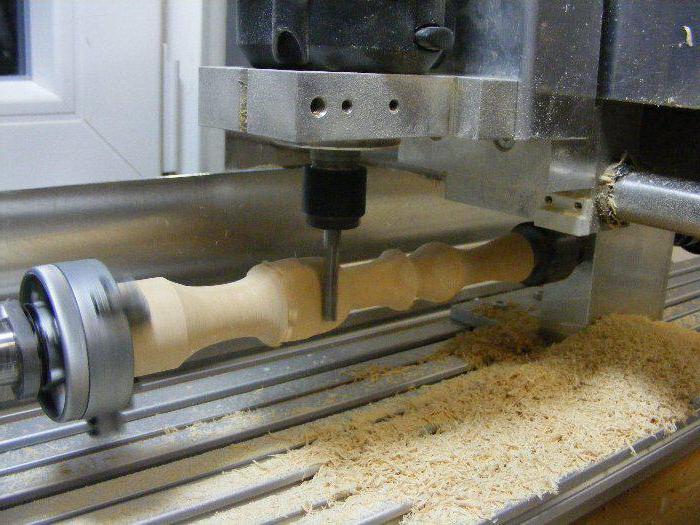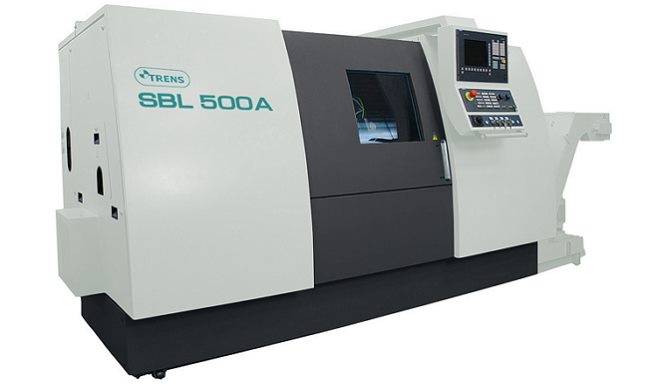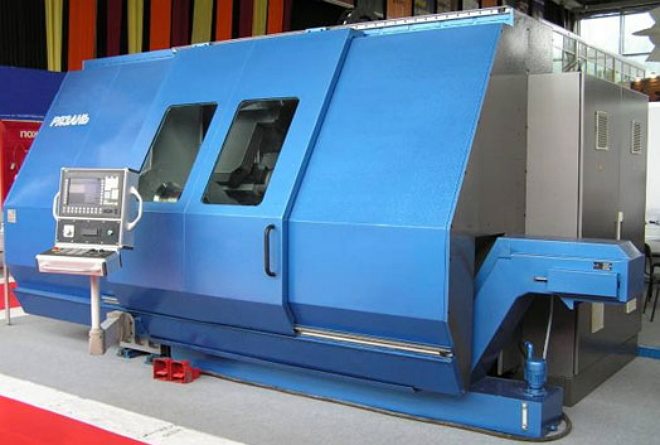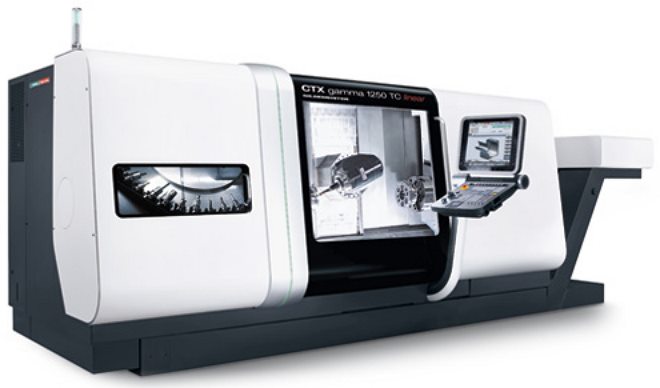Other CNC centers for metal processing. Turning and milling machine - what gives us its versatility
Wood and metal blanks are still in demand in various industries. The use of turning and milling operations allows you to obtain optimal results for the formation of parts while ensuring high accuracy and minimum costs. However, the quality of processing and the financial feasibility of using such methods of manufacturing materials largely depend on the equipment used. They are presented on the market quite widely - in different configurations, structural and functional versions.
General information about milling and turning machines
Machines of this type are combined equipment designed to perform a wide range of operations. For both groups technological processes separate drives are provided. Typically, turning and milling machines are used where it is necessary to alternately perform different processing actions. As for the design, it is formed by two parts. The milling department is located vertically, and the horizontal turning segment acts as a kind of base, including the bed, spindle and tailstock.
The specific design determines the possibility of performing different types of operations: from shaping to boring holes. Also, some models provide for the addition of third-party functional equipment, which increases the efficiency of processing processes. For example, they are often supplemented with bed extensions, which make it possible to work with larger workpieces.
Machine tools for metal

In the traditional version, such units perform the operations of drilling, cutting and sharpening metal blanks. On condition correct use capacity of the unit, the material can be given almost any shape. Manufacturers of industrial equipment produce with different levels of performance. Typically, low-power machines are distinguished for workshops and small production lines, as well as high-performance machines for demanding and large-scale processing operations.
Low-power models include machines with a power potential of up to 400 watts. Such equipment is characterized by a relatively modest mass and can be installed on a workbench or table. Units with a power of more than 1000 W are most often used for milling and drilling. In such performance turning-milling machine for metal can be found in the equipment large factories, including from the heavy industry segment.
Woodworking machines

Machines from this category, of course, have lower power indicators, but in terms of operating flexibility they outperform units working with metal. However, most often such equipment is used for typical serial cutting or milling operations with the creation of grooves. Also in the furniture industry, the operation of curvilinear curly cutting is common. To date, turning and milling machines for wood processing are offered for both professional and semi-professional tasks. The differences between these segments are mainly reduced to the dimensions of the units and design features.
Main characteristics
Although the quality of work is largely determined by how the design and mechanics of the machine are focused on servicing specific workpieces, in the first place in technical parameters experts put power. For machines of this type for wood, the average range is 300-700 watts, and models focused on metal processing have 400-1000 watts. In addition, it is important to take into account the distance between the centers of the machine, which will determine the length of a suitable workpiece. Modern turning and milling machines are capable of working with workpiece lengths of about 75 cm. But again, there are types of equipment that allow you to expand such characteristics. The size of the processing diameter is also important, which can be up to 22 cm. A more in-depth analysis of technical indicators should be determined based on the tasks for which the machine is selected. Depending on the operations, the future owner can also evaluate the sharpening depth, cutter parameters, tooling limits, etc.

CNC Turning and Milling Machine - what is special?
In fact, these are automatic machines that have the ability to perform processing without operator control. In the most advanced models of this type, the user initially sets the processing program with certain parameters and leaves the unit to perform the tasks. The software type of control allows you to make more precise settings for the rotation speed, processing characteristics and other indicators. It is important to note that the CNC turn-mill can automatically change the processing parameters depending on external conditions. From special sensors, the control controller can receive information, for example, about temperature. And if an excess of permissible heating indicators is recorded, then the unit will either stop on its own or reduce the pace of work.
Conclusion

A variety of designs in which modern machines are presented allows them to be installed in any suitable places: from the workbench to the factory production line. You should look for the right models in the lines of manufacturers Jet, Oneway, Sturm, as well as the domestic manufacturer Enkor. The specialists of these companies offer the most functional, safe and flexible milling and turning machines. The price of semi-professional models for wood processing is on average 15-25 thousand rubles. And vice versa, the professional segment of equipment designed for metal blanks has offers of about 70-100 thousand. However, a lot also depends on the operating parameters of a particular model, and on its configuration with functional support.
A CNC turning and milling machine for metal work, also called a machining center, can be found today on many manufacturing enterprises. The widest possibilities of such universal equipment allow to subject metal workpieces to high-quality turning and milling.
Types of turning and milling centers on the modern market
Machine tools in this category are divided into two large groups: devices without CNC and CNC. Equipment without a CNC system includes manual, semi-automatic and automated machines. Within the framework of this article, devices are considered that implement a numerical program control. CNC machining centers manufactured by modern industry are divided into several types:
- simple design;
- with counter spindle;
- with drive center;
- with installed C-axis.
What unites these machining centers, which have their own design features, is that they simultaneously have the functionality of turning and milling machines.

Characteristics of turning-milling machining centers
Run multiple types technological operations(drilling, turning and milling) on one device allow and, but due to the insufficiently high mobility of revolvers, the volume of products produced with their help is limited.
Turning and milling machining centers, in the design of which there is a special milling head, are deprived of this drawback. The landing hole in such a head can be made under different types cones (Capto, HSK, BT or ISO), which allows you to install . Due to this, such turning-milling machines can be used to perform such technological operations on metal as drilling, countersinking, threading, creating chamfers and grooves, facing and trimming, reaming, etc.
Using a special adapter arbor, square shank cutters and cutting tools with a special shape of the seat can be mounted on CNC machining centers. In one spindle of machines of this category, both a stationary and a rotating working tool can be fixed. Tools are changed in turning-milling machining centers equipped with a CNC system automatically; a special mechanism is responsible for this in the design of the machine - a changer.
CNC machining centers are most widely used in enterprises that are engaged in the manufacture of complex shapes metal parts and structures. In the production of such products, it is necessary to repeatedly alternate the operations of turning and milling, which is provided by a turning-milling machining center.
Machining centers mainly use solid type tools or with replaceable inserts made of carbide. In very rare cases, a tool whose cutting inserts are fixed by soldering can be used.

Machining centers with counter spindle and C-axis
Equipment with a C-axis is one of the first modifications of the machining center of the turning and milling group. To impart rotation to the cutting tool (drill and cutter), a separate drive is installed on such a machine. For the automated change of tools on this turning-milling device, as well as on other types of machining centers, a special mechanism is responsible - the changer.
Important functions of C-axis machining centers are control over the speed of rotation of the workpiece and indexing of its angular position. The accuracy of such indexing, which is important, is about 0.001 degrees.
Turning and milling machining centers with C-axis when equipped with a change mechanism cutting tools allow you to perform technological operations that ordinary lathes cannot handle. In particular, these operations are:

- milling processing of elements of worm gears;
- production and processing of crankshafts;
- gear processing.
Equipping CNC machining centers with a counter spindle is the next stage in the development of turning and milling devices. The second spindle of such machines, which have even greater functionality, is installed instead of the tailstock. Inserted into it Right side workpiece, which makes it possible to process its opposite edge.
Equipping the machining center with a counter spindle allows turning this device into a full-fledged production line with exceptional functionality. If such a milling and turning machining center is equipped with a second tool changer, then the efficiency of its use will increase significantly. What is important, the quality of processing will not suffer from this at all.
You can clearly see the principle of operation of the counter spindle in the video below:
On the modern market presented big variety machining centers for metal various manufacturers. Let's consider some of them.
TRENS brand machining centers
Milling and turning machining centers of this trademark have a special design and feature- inclined frame. This gives the machines exceptional strength and rigidity, which allows them to machine parts with high precision. As a rule, large- and medium-scale productions engaged in the production of parts with a complex configuration are equipped with such equipment. We list the most popular models of turning this brand.
SBL 300
The design of this model is simpler than that discussed above, which does not prevent such a machine from effectively coping with threading, basic milling operations, and processing parts of complex configuration. special attention deserves a machine spindle, characterized by high rigidity and exceptional reliability, which makes it possible to operate it on high speeds pretty long. No less remarkable are the characteristics of the C-axis this device, which creates excellent torque and provides fast switching of operating modes. Manufacturers managed to achieve such characteristics of the C-axis due to the fact that it has a special disk-type fixation system.

CNC machine Trens SBL 300 made in Slovakia
SBL 500A
The capabilities of the machine of this model allow processing workpieces on it, the weight of which reaches 1050 kg. The machining center is equipped with a TM Siemens or Fagor electric drive, its design has a counter spindle, an easily adjustable and reliable CNC system. The movement of the headstock of the machine and the fixation of workpieces are carried out using hydraulic mechanisms. The possibilities of such a CNC turning-milling machining center are also evidenced by the fact that it can perform the most complex technological operation - off-axis drilling - in one installation.

SBL 700
This CNC milling center is the most modern model equipment manufactured under TM TRENS. The technical capabilities of such a machine make it possible to process metal blanks of rectilinear, stepped and curvilinear configurations, the weight of which can reach up to 2500 kg. The machining center is equipped with a CNC TM Siemens, which ensures precise movement of the tool during processing. The operation of the machine and the movement of the tool in such a CNC system is described by simple 3D programming, and its connection to the device is provided via the Ethernet protocol.

Machining center model 1728C
The universal machining center of this model has earned special popularity in Russia. Functionality allows such a device to cope with the following technological operations for processing metal blanks: drilling straight and under given angle, boring, chiselling, conventional and contour milling, turning with milling cutters, etc. It is possible to process metal blanks on this both in the chuck and in its centers. The high accuracy with which workpieces are processed at this center is ensured by its following design features.
- The main components of the machine are characterized by increased rigidity and vibration resistance.
- High precision bearings are installed in the equipment nodes.
- The design of the machine includes special thermosymmetric elements that compensate for deformations arising from temperature effects.
- The movement and operation of the tool is constantly monitored by special elements.
- The equipment is equipped with modern and reliable system CNC.

The turning and milling machine of this model allows processing workpieces with a diameter of up to 40 cm and a length of up to 3 meters. The spindle of the machine has an end size of A8, a chuck with a cross section of 40 cm is installed on it, the hole diameter in which is 9.7 cm.
Any turning and milling machining center, including this model, can significantly reduce the cost of performing technological operations in the complex.
Brief overview of other models of machining centers
At Russian manufacturing enterprises engaged in the production of metal and wood products, machining centers manufactured in Taiwan under the TAKISAWA trademark are popular. With their exceptional functionality, the machines of this brand are distinguished by their affordable cost. On the modern market, TAKISAWA TM equipment is represented by the following series: LA, NEX, EX and LS. Machine tools of these series are successfully used at enterprises of the automotive and aircraft building industries, at machine-building plants.

The most popular models of TM TAKISAWA equipment are 4500TT, 4500S, 4500ST. The design of the machines of these models has two turning units and one milling unit, their magazine for tools and working devices can accommodate up to 90 positions. Such machines, equipped with a turret, provide high accuracy and efficiency in turning and.
Among the machining centers of the turning and milling group, which have earned high popularity among domestic manufacturers, it is worth noting the machines of the Spanish company GMTK, which are also produced in several series: HR800, HR1000, HR1200, HR1500. The use of such CNC machining centers is necessary for the manufacture of metal parts that are highly complex and must be machined with maximum precision.
Among the unique design features of this equipment, the following can be distinguished: tool changer and working heads, hydrostatic guides, temperature stabilization system. The purchase of CNC machining centers from the Spanish company GMTK is required by enterprises whose products are characterized by high complexity and precision of processing.

There are a number of foreign companies whose machining centers have proven themselves among domestic manufacturing enterprises.
Victor (Taiwan)
The company has been producing equipment for processing metal and wood blanks for more than 70 years. Its machines are characterized by a reliable and technological design, quality components. It is noteworthy that the company uses a special grade of cast iron to manufacture the beds of its equipment.
MULTICUT (Czech Republic)
Under this trademark, universal equipment is produced, equipped with modern systems CNC. Depending on the need, the machines can be equipped with a tailstock or a second spindle. The technical capabilities of the equipment of this brand allow milling workpieces in five coordinates, turning, grinding and slotting, as well as milling cams and performing other metal operations.
DMC (South Korea)
The machining centers of this company, which are distinguished by exceptional functionality and high productivity, belong to the premium class category.
The list of names of lathes for metal includes the largest number positions among metalworking equipment. The processing of workpieces in the process of cutting or turning is their main function.
With the help of lathes, you can perform the following operations:
- turning and boring surfaces (cylindrical, shaped and conical);
- thread cutting;
- drilling;
- end processing, etc.
Milling machines are designed for processing wooden surfaces and metal cutting. With their help, various shaped and flat surfaces, bevel and gear wheels, rotation bodies, etc. are processed. The main element of this type of machine tool is a cutter. Operating principle milling machine lies in the fact that the milling cutter installed in the spindle during processing performs rotation, and the workpiece fixed on the desktop performs the feed movement. Movement can be either in a straight line or along an inclined line.
Types of control system for milling machines
- manual;
- automated;
- CNC control.
In the equipment parks of metalworking companies, there are also multi-purpose machines - turning and milling machining centers. Their peculiarity lies in the fact that they simultaneously perform the functions of turning and milling machines.
When choosing turning and milling equipment with CNC, it is necessary to take into account the type of material that is to be processed on this equipment. CNC turning and milling machines have high performance in processing products from non-ferrous metals and their alloys, steel, plastics, etc.
Specific in structure, but universal in application, are desktop turning and milling machines, in which two machines with separate drives are combined at once. This is an indispensable solution for occasional situations where both turning and milling operations need to be carried out in the workshop.
Structurally this machine consists of paired parts - horizontal turning (with its own bed, spindle and tailstock) and vertical milling (in which the spindle is located in the central part of the bed).
The operations that the desktop turning-milling machine performs are through-turning along the workpiece cylinder or shaping with a curly cutter, facing, chamfering, coning and picking fillets, boring holes. Cutting is possible with the help of the tailstock internal thread tap and external thread die.
The milling part provides the possibility of cutting straight and curved grooves on the outer surfaces, as well as drilling holes. The installation of grinding wheels together with the movement of the table in the horizontal plane along both coordinates makes it possible to grind the outer surfaces of the installed part.
Important technical specifications
- Distance between centers (up to 750 mm) - determines the maximum length of the installed workpiece.
- Maximum turning diameter over bed (up to 220 mm) - limiting diameter cylindrical bar for turning.
- Max Depth turning in 1 pass (up to 0.2-0.3 mm) - the maximum allowance, which the turning-milling machine removes in one pass of the cutter during turning, characterizes the performance of the machine.
- Maximum diameter of end and end mill (13 and 30 mm) - the limiting dimensions of the installed in milling spindle tools.
If you are interested in universal turning and milling machines, then when ordering on our website, they will be delivered to any city in the Russian Federation in a few days.





